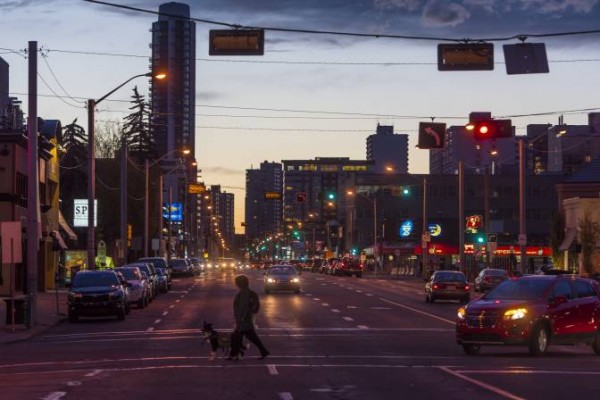Jasper Avenue is said to be Edmonton’s main street. But what does that mean? Its multiple uses–as destination and as thoroughfare, as pedestrian street, as transit street, as automobile corridor–leave it unresolved and uncertain what it is intended to be. Within downtown, there is a new vision for a more pedestrian-oriented, ceremonial street in the centre of Edmonton. But west of 109 Street a vision is lacking. Now, the City has begun an engagement process for renewing this portion of Jasper Avenue. This is a chance to think about the bigger questions of what we want this street, our main street, and our city to be.
Today, Jasper Avenue through Oliver looks a lot like many other high-traffic arterial roads throughout Edmonton. The street is wide, loud, grey and surrounded by parking lots. Sidewalks are narrow and unpleasant. Consider the contrast between walking in the summer and walking in a snowstorm: winter brings traffic down to slower speeds and mutes the harsh noises. In the summer, quieter and shaded side streets are more attractive places to be. We’ve created a main street that’s often nicer to avoid than to be part of. This process is a chance to think about how we shape this space, and in doing so start to think about bigger questions about what we want our city, and its transportation system, to be–questions such as:
- How can Jasper Avenue and the surrounding streets be connected and made safe for pedestrians walking along and crossing the street?
- What does an accessible and vibrant pedestrian-oriented main street look like in a winter city?
- What amenities should there be on the street to encourage pedestrian activity?
- How should cycling along Jasper Avenue be accommodated and encouraged?
- How can Jasper Avenue better perform its role as an important transit corridor, prioritizing buses in ways that complement pedestrian activity?
- How quickly should people expect to be able to drive down a main street?
These abstract questions are answered in practice by specific interventions in how the street is configured, how it looks and how it functions. So we also need to think about questions like:
- How wide should crosswalks be?
- How long should pedestrians be expected to wait to cross the street?
- Are there particular intersections that need extra attention?
- Are there special places along Jasper Avenue that should be marked?
The configuration of streets is often thought of in technical terms–specifically, that they need to move a certain number of cars per hour at a certain speed. But streets really reflect the choices we make about how we share space among different uses, different types of transportation and how we interact with each other in public spaces. Streets aren’t separable from the places they connect, and they reflect the land-use planning choices we make as well. The conversations taking place about Jasper Avenue are a chance to start thinking about how these things interact, and what we really mean when we call Jasper Avenue our main street.


2 comments
Would love to see an elm tree boulevard on Jasper.
Somehow, Edmonton manages to do everything half-ways. If you walk the most recent sidewalk renovation on Jasper Ave. You’ll notice poor workmanship and poor design hand-in-hand. In fact, the widened sidewalk now sports a drainage depression right in the middle. Also the black marble benches are very uninviting. Being black marble they are scorching hot in summer, ice-cold any other time and of the size and shape as to evoke sarcophagi. If you go to 108 St, you see more of this poor design at work. The planters in the median were intended to be benches – in the middle of the street. Their design is again uninviting, unattractive, and – in the middle of the street. I see they’ve put parking-lot pillar barricades around them to stop drivers of giant 4x4s from simply driving over them out of annoyance at this bench-thing occupying a good portion of the roadway. Something that could work on Jasper Ave is to require buildings to have canopies projecting over the sidewalk to keep snow, rain and wind to a minimum. The canopies could be made from glass and wrought iron, or a more modern look. Attractive lighting could be included. This could bring more life onto the sidewalks, it would certainly make Jasper Ave more walkable. Of course the argument against this idea is the canopies would attract the homeless. Another example of using ‘security’ as an excuse not to do something to humanize our built environment.